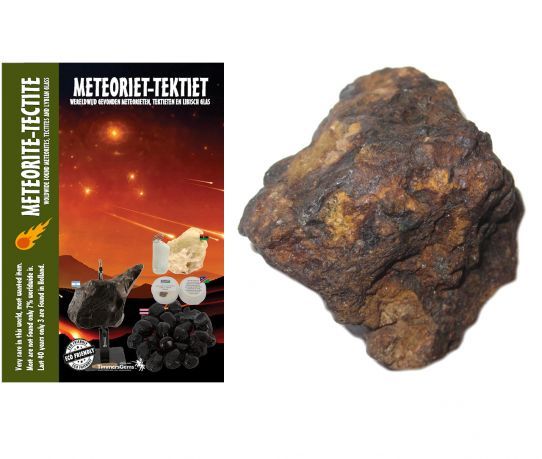We use cookies to make your experience better.
Mundrabilla Meteorite from Australia Nickel iron
- Buy 100 for €13.00 each and save 19%
A meteorite is the part of a meteoroid impinges after it on the earth from space to have fallen through the atmosphere. During the trip through the atmosphere, the material is greatly slowed and very hot; this can be seen as a meteor. Essentially, a meteorite debris from space. On the basis of the composition of meteorites can sometimes be determined what the source is. For example, there are already more than twenty were found which are derived from the moon. This refers to material that another meteorite from the moon's out of control. There are also meteorites, such as ALH84001 found whose origin is Mars. In many cases, however, the meteorite came from the asteroid belt (also called asteroid belt) between Mars and Jupiter. Whether there meteorites consist of a cometary origin, is still under discussion. It is possible that some rare and very fragile species of carbonaceous meteorites of short-period comets originate. A lot of debris that comes in contact with the atmosphere does not reach the earth, but burns by the resistance of the atmosphere. The fragments that burn in the night visible as meteors, also called star rain or shooting star. For larger items that do not completely burn only partially as meteorites land on Earth, occurs when passing the atmosphere a bolide (fireball). That it can be an impressive phenomenon is apparent in the car of the Sikhote-Alin. That was very visible in full daylight. The fireball caused by the Dutch Glanerbrug meteorite from April 1990, just before sunset was visible.
The Mundrabilla meteorite is one of the largest meteorites found on Earth. The first fragment was discovered in Australia in 1911. The Mundrabilla meteorite is an iron meteorite found in Australia in 1911, one of the largest meteorites found, with a total known weight of 22 tons and the main mass (the largest fragment) accounting for 12.4 tons. In 1911, a 112 g iron meteorite fragment was found by Harry Kent, foreman in charge of camels for the West Australian Transcontinental Railway Survey, at 31 ° 1 ′ south latitude, 127 ° 23 ′ E, at the Premier Downs station on Nullarbor . Just. The small meteorite was called Premier Downs I. Later in 1911, Kent found another small iron meteorite (116 g) about 13 kilometers (8.1 mi) west of the found site of Premier Downs I, named Premier Downs II. Both meteorites were medium octahedrites, believed to be part of the same trap. It has been suggested that the Mundrabilla meteorites are closely related to the Loongana Station and Premier Downs meteorites, and fell from the same mass during atmospheric ablation.Mundrabilla I, the main mass of 12.4 tons, is now preserved at the Western Australia Museum .












